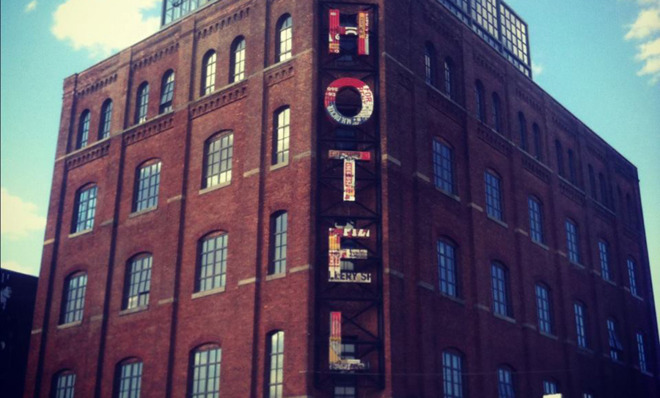The booming hipster hotel business, from Brooklyn to Paris
When it comes to hiring staff, mustaches, beards, and tattoos seem to be a priority


Two high-profile stories this year in The New York Times Style Magazine and The New York Times illustrate Brooklyn's role as the purveyor of cool to urban environments around the world.
Although maligned by many, "Brooklynization" has spread through post-industrial neighborhoods worldwide. For example, regarding the suddenly hot 'burb of Canal St-Martin in Paris, Conde Nast Traveler's recent cover story describes the region in the 10th arrondisement as the Brooklyn of Paris, identified by the rise of the French 'ipster.
That goes double for hotel design. Suddenly, every hot hotel for the Millennial traveler is catering to the grunge-meets-geek-meets-grad-school crowd. New hotels like the 72-room Wythe Hotel in Brooklyn look and feel like they were conceived over darts and craft beer by a group of anti-establishment friends employed as welders, baristas, and vintage boutique shopgirls.
The Week
Escape your echo chamber. Get the facts behind the news, plus analysis from multiple perspectives.

Sign up for The Week's Free Newsletters
From our morning news briefing to a weekly Good News Newsletter, get the best of The Week delivered directly to your inbox.
From our morning news briefing to a weekly Good News Newsletter, get the best of The Week delivered directly to your inbox.
Having visited both the Wythe and brand new Hotel FABRIC in Canal St-Martin recently, it's easy to see the commonalities between the two hotels and their communities.
First, let's define "Hotel Brooklyn":
- Adaptive reuse architecture is a big one, recycling historic buildings with a priority for responsible preservation of design elements and character of the original structure.
- The "industrial-chic" design trend highlights the bones of the building, ranging from heavy steel girders to duct work, to create a raw, immediate energy that emulates the work/live loft experience.
- There's often a nod to vintage/retro art and furnishings channeling Mid-Century Modern design. See Jonathan Adler/Palm Springs Modernism Week.
- Food and beverage (F&B) is always local with an emphasis on small-batch purveyors. Kitchens are often helmed by a name chef with successful outlets elsewhere in the region.
- Special events and pop-up installations are a platform to support local artists, musicians and other creative types, which helps keep the vibe fresh, hip and unpredictable.
- Staff hiring places a premium on educated, culturally deft and down-to-earth personalities with well developed art, fashion, and music tastes. Mustaches, beards, and tattoos seem to be a bonus. Bitchy, aloof attitudes should stay home.
- Communal tables and numerous other places to work on a laptop are a must.
- Above all else, these streetwise hotels cater to local clientele, which is good for the bottom line, and it offers guests a more immersive travel experience.
The darling of travel/design mags in 2012, the Wythe Hotel lives inside a former barrel and cask "cooperage" constructed in 1901 near the waterfront. Guest rooms feature hard plank floors, beds constructed out of reclaimed ceiling timbers, and wall-to-wall industrial windows with incredible views of Manhattan's skyline. The Ides Bar up on the roof inside a new glass extension crowning the post-industrial neighborhood is high in demand for private parties after all of the buzz surrounding events here during New York Fashion Week.
Local celeb restaurateur Andrew Tarlow is co-owner of Wythe. He operates the onsite Reynard restaurant with the same gusto for upscale locavore cuisine as his other area restaurants, Marlow & Sons, Diner, and Roman's. The menu highlights market-driven American fare prepared over a wood-fired grill, served inside a comfy dining room with original brick walls, cast iron columns, pine beams, and tall arch windows. A grass-fed sirloin with grilled potato, bacon, and bordelaise is $29.
A free daily email with the biggest news stories of the day – and the best features from TheWeek.com
In this GQ interview, Tarlow explains his communal culinary direction at Wythe:
I see the restaurant as being the focal point and the meeting point of the hotel for traveling guests and certainly the local people in the community who live around here. So the notion is that we really want those two worlds to collide and be together and use this big grand bar and this place as the centerpiece for that…. The idea is that people come to a table and gather around in a communal space, and whether you know everyone, you should feel like you will get to know everyone. [GQ]
The inventiveness in the kitchen is the same as what Europeans call "bistronomy," where fine-dining chefs open mid-market restaurants due to soft demand for haute cuisine. It's also how the next breed of boutique hotels are making their mark, especially with creative special events. For example, Chef Inaki Aizpitarte of Le Chateaubriand in Paris spent three nights cooking with Chef Sean Rembold at Reynard.
Brooklyn of Paris
The Canal St-Martin neighborhood is named after the waterway bisecting northern Paris, originally built by Napolean to deliver water from the Seine to the outlying masses. The streets here are eternally less busy and touristy than the Left and Right Bank, and it's a favorite getaway for Parisians of all economic classes.
The 33-room Hotel FABRIC opened in June in Canal St-Martin inside a converted textile factory. The lobby is trimmed out with a giant kleig light, central communal table, and glass bookcases filled with accouterments from the mid-20th century.
Upstairs, the guest rooms have large multi-pane steel windows and unfinished wardrobes designed like wooden shipping pallets.
From Hotel FABRIC's website:
Architect Vincent Bastie, with interior designers Agnès Louboutin and Patrice Henry, has maintained the functional ambience and blended it with an inspiring modernity. This approach is exemplified by the lobby, where design features have been made of the cement tiles, the distinctive oak of the guest table and the comfortable leather Chesterfield. The breakfast buffet furniture was reclaimed from a former notions and haberdashery in the Vosges region and a magnificent piece of worktop furniture has been restored for the reception desk.
Hotel FABRIC does not have a restaurant. Nearby on the canal, Hotel du Nord has a restaurant but no hotel. Originally built in 1885, the Nord once catered to transient workers. Today, it's a popular local bistro with a classic zinc bar, subway tiles, and small wooden tables. A big brown bag of fresh baguettes sits on the floor, the espresso machine doesn't stop, the locals eat cheeseburgers (which are awesome), and the wait staff is gracious and attentive.
The FABRIC and Nord complement each other. They're like antipolar foils from two different generations connected by similar narratives in their design and sense of purpose. A collision of two worlds, as Tarlow said. Each is viscerally connected to the community. They are the community.
The French residents here are loathe, of course, to define themselves as the Brooklyn of Paris. For them, the neighborhood has always been this way, so they could just as easily say that Brooklyn is the Canal St-Martin of America.
More from Skift...
-
 Quiz of The Week: 29 November – 5 December
Quiz of The Week: 29 November – 5 DecemberQuiz Have you been paying attention to The Week’s news?
-
 The week’s best photos
The week’s best photosIn Pictures A drive in the desert, prayers with pigeons, and more
-
 The Week Unwrapped: Will drought fuel global violence?
The Week Unwrapped: Will drought fuel global violence?Podcast Plus why did Trump pardon a drug-trafficking president? And are romantic comedies in terminal decline?